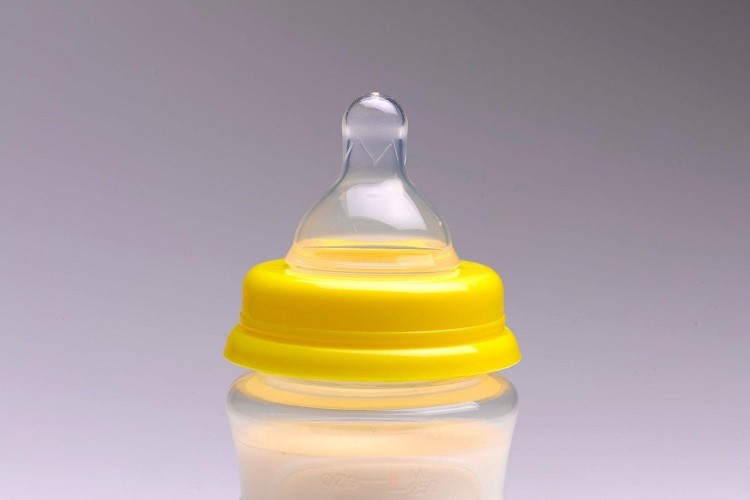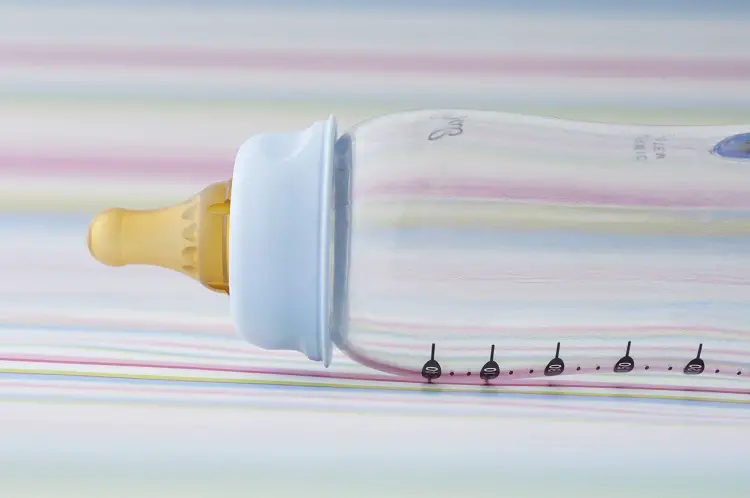As a new parent, you will be dealing with many stains in places you cannot imagine, even the baby’s bottle nipples.
If you are wondering how to get yellow stains out of baby bottle nipples, soak the rubber nipples in a water-white vinegar solution for 30 minutes.
These stains are fat residues from breast milk, which stick to the surface of the nipples and will not quickly go away if you don’t use the proper cleaning methods described in this article.
How To Get Yellow Stains Out of Baby Bottle Nipples
Feeding time is the perfect time for bonding with your little one. Transitioning from direct breastfeeding to bottles comes with many experiences that can be both fun and challenging.
Knowing the right bottles to choose, the brands, sizes, the type of nipples, and how to maintain them are some challenges you’ll face.
Sometimes you may find yourself searching for effective ways of how to get yellow stains out of baby bottle nipples.
But as a parent, the first step in solving problems relating to your baby is to understand the roots of the problem. That way, you will have a solution and discover ways to prevent a recurrence.
In the same light, you have to understand why the nipples of your baby’s bottle are yellow and cloudy to know how best to clean them.
Reasons For Yellow Stains On Baby Bottle Nipples
There are several causes of yellow stains in bottle nipples. Some could be as basic and harmless as fat deposited on the surface of the nipples, while others could mean more.
Here are some primary causes of yellow stains on bottle nipples:
Fat Residue
Fat deposits are one common reason for yellowing in bottles and bottle nipples. Usually, some parents are fond of just rinsing the bottles without using liquid soap or detergent to wash them.
If you put a finger into a bottle rinsed without soap, you’ll feel the oil left in them. Over time this oil undergoes discoloration and appears cloudy or yellowish in the bottles.
Pigmentation
The pigments in some foods like formula milk, juices, flavored drinks, or colored vegetables and fruits like beetroot, strawberry, spinach, or tomatoes can also cause discoloration in bottle nipples.
When you blend these vegetables and fruits, their pigments deposit in the bottles and cause discoloration if not properly washed.
Cleaning Agents
Using harsh chemicals on these materials can cause abrasions that will absorb stains and make cleaning harder.
Even though excessive scrubbing can help in some cases, it is the reverse for baby bottles, as excessively scrubbing them can make them appear dirtier.
Dishwashing Baby Bottle
If you put the baby bottle in a dishwasher alongside other dishes, the bottle can pick up new stains from the dishes.
Calcium Build-up
Using hard water to wash the bottles can also lead to color changes in the bottle. This is not just for the bottle alone; hard water generally leads to discoloration on materials like clothes and plastic and is bad for the skin.
High-Temperature Water
To sterilize the bottles, some parents use high-temperature water to soak them to kill any germs that may cling to them. Even though this will effectively kill the germs, it’ll affect the appearance of the bottles and give them a worn-out look.
Steps on How To Get Yellow Stains Out of Baby Bottle Nipples

To save yourself the trouble of dealing with stains on bottles, get a stain-resistant bottle, like the Tommee Tippee Silicone Baby Bottle.
The advantage of stain-resistant bottles is that they have a longer span since they’re not susceptible to discoloration from food pigments and are often odor resistant also.
However, if you already use a bottle with yellow stains on the nipples, here are practical tips on how to get rid of the stains:
- Wash the bottles after every use. It’s not enough to rinse out any milk remnants in the bottles. It is also not hygienic. Use a mild detergent to create soapy water. Then use a soft brush to wash the bottles thoroughly before storing them.
- Use White Vinegar to remove the stains. Vinegar is a cleaning agent that effectively removes stains without any damage. Mix two tablespoons of vinegar in two cups of water or enough volume to submerge the bottles and soak them for 30 minutes. Vinegar will not just clean but also sterilize the bottle of any bacteria.
- After using vinegar, run a cold water rinse on the bottles to remove any leftover vinegar to prevent milk curdling.
- If there are still stains after you use vinegar, use baking soda.
- Add a tablespoon baking soda to a warm water bottle and leave it overnight. Use the solution to scrub the bottle with a silicone brush.
These steps will eliminate the stubborn stains and persisting odor in the bottles.
Is It Safe To Use Baby Bottle Nipples With Yellow Stains?
To a certain degree, using baby bottle nipples with yellow stains is harmless, especially if you try to be mindful of your spending.
Many baby bottle companies attribute the yellowish discoloration to the materials used in making these bottles. The polymers in the plastic used in the bottles tend to change or appear a certain way when exposed to some factors.
Cloudiness in the bottles can be an irritating sight and may tempt you to throw them away. If you’re buoyant enough to change them periodically, then why not?.
However, even new bottles are subject to change and discoloration if misused or poorly maintained.
If you follow the steps on how to get yellow stains out of bottle nipples, you’ll be able to give the teat a new look while preparing for replacements.
Due to the nature of the materials used, some bottles are more durable than others.
However, when your baby’s bottle nipples begin to chip away, tear and change shape, it is time to replace them with a new ones.
A better way to ensure that your baby eats only from a safe bottle is by replacing them regularly in the space of 4 to 6 months when it must have served their purpose.
Related Posts:
- How To Clean Baby Yellow Teeth
- Baby Drinks Bottle Too Fast (Here is What To Do)
- What To Do With Used Baby Bottles (8 Creative Ideas)
Frequently Asked Questions
How often should I replace baby bottle nipples?
It is best to change bottle nipples every three months once your little one is comfortable with one. If you spot a crack anywhere, you need to change the nipple right away.
Why do baby feeding bottle nipples get cloudy?
The heat from boiling water, microwaves, or dishwashers can damage the plastic when used in these ways. They become soft at high temperatures, and their original arrangement of plastic molecules may be disrupted, which could eventually cause cloudy baby bottles.
How often should I sterilize baby bottle nipples?
You don’t have to sterilize your baby’s bottles and supplies each time you feed him or her after the first time you sterilize nipples and bottles in boiling water for five minutes. Wash the bottles and nipples in hot, soapy water (or in the dishwasher) after each use.
What happens if you don’t sterilize baby feeding bottles?
Improperly cleaned baby feeding bottles can attract germs that might make newborns sick. There is a possibility that unsterilized baby bottles can carry the Hepatitis A Virus and Rotavirus, both of which can be transmitted through poor sanitation practices.
Hepatitis A Virus can infect your baby’s liver, and Rotavirus can cause dehydration and diarrhea.
How do you remove the yellow tint from plastic?
Plastics that have become entirely yellow rather than just a small spot of yellow can be restored using hydrogen peroxide. Fill a plastic bag with enough hydrogen peroxide to immerse the plastic fully.
Place the plastic in the hydrogen peroxide bag and let it sit in direct sunlight for 3-4 hours before rinsing it off.
When should you throw away used baby bottles?
Proper care and maintenance can increase your bottles’ safety and life span. Generally, bottles should be replaced every 4-6 months. However, if the glass bottles are in good condition, you may have to replace them less frequently.
Should baby bottles be completely dry before use?
You do not need to dry a baby bottle if you are using it immediately, but you should completely dry it before storing it. Drying your baby bottles is essential to cleaning to prevent bacteria growth.
How can I get milk residue out of a bottle?
Using hot water and dishwashing detergent, you can get milk residue from a bottle.
Using a teat brush, clean any milk still in the teat or hole. Use a bottle brush to clean all areas of the bottle, including the thread where the cap screws on. Rinse the teat with clean water after squeezing hot, soapy water through the hole.
Conclusion
If you can’t prevent the yellowish stains in your baby’s bottle nipples, you can at least have routine maintenance on how to get yellow stains out of baby bottle nipples.
These stains may seem normal if you’re not much of a meticulous person. However, it sends the wrong message about you and can make people question your parenting methods, considering that it appears dirty and unsafe.
